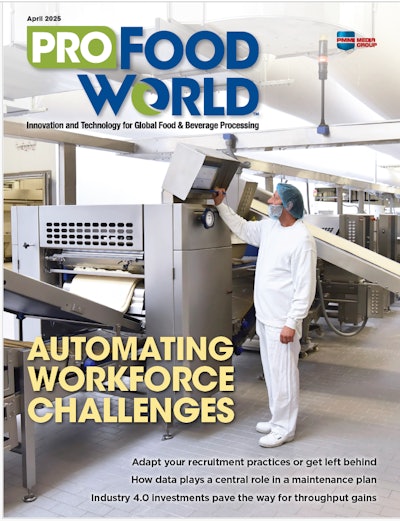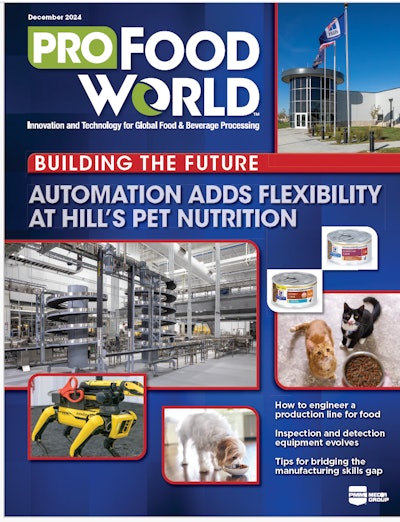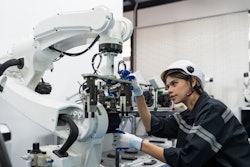"We need more welders and less philosophers.” Republican Sen. Marco Rubio’s, statement marked a key moment in the presidential debate and started a discussion about blue-collar jobs in America.
Donald J. Trump continued that discussion by making American manufacturing jobs a central part of his campaign platform, promising to bring back those jobs to America. He now calls on U.S. companies to hire American workers. But some industry insiders argue that there are too many jobs and not enough workers to fill them.
As a result, the food industry and others are experiencing a “thinning” in manufacturing. According to the PMMI Vision 2020 Report, the “thinning out” of American manufacturing and beyond exerts tremendous pressure on CPGs at a time when consumer demands are growing and more is expected. Other dynamics of “thinning” include consolidation through mergers and acquisitions, significant cost cutting and job reductions, doing more with less, and further cost-cutting measures designed to improve overall profitability and increase shareholder value.
There’s a disconnect
Mike Rowe, former host of Discovery Channel’s “Dirty Jobs” and founder of the mikeroweWORKS Foundation, says there are upwards of 5.6 million jobs unfilled in America, and 75 percent of them do not require a four-year college degree. The problem, he says, is a skills gap. During a May 26 interview on the Fox News Channel with Tucker Carlson, Rowe said: [The American education system] took vocational-technical training out of high schools and told an entire generation that their best hope for success is a four-year degree. Guidance counselors push four-year degrees, and parents want better for their kids. Somewhere in the reptilian part of our brain, we believe that manufacturing jobs are substandard, and that’s dumb. Manufacturing jobs are important jobs, but they are not being celebrated.”
As chair of PMMI’s OpX Leadership Network’s Executive Council, Greg Flickinger has a bird’s eye view of what is occurring within CPG companies. While he is quick to point out that much of what he sees and hears is not necessarily happening within his organization (he is also vice president of manufacturing operations at H-E-B, a privately held supermarket chain based in San Antonio, Texas), Flickinger does admit that there is a thinning in manufacturing, and it is indeed taking its toll, from meeting production schedules to serving customers.
He says a combination of things have led to thinning, notably that the talent pool is drying up as longtime employees retire. When knowledge leaves an organization, maintaining customer-service levels, production schedules and food quality can be at risk.
And attracting and retaining new hires is easier said than done because there has been a marked de-emphasis of learning a trade in the education system. “High schools no longer offer shop class, and technical schools have fallen out of favor,” Flickinger says.
As a result, it has become increasingly difficult to find people willing and able to work in manufacturing. And it’s getting harder to find talent for the jobs that require higher technical competency, says Flickinger.
Manufacturing used to be able to turn to the immigrant community to fill lower-level positions, but that is not necessarily how things will continue, says Gardner Carrick, vice president of strategic initiatives at The Manufacturing Institute. “Today, manufacturing jobs are very good jobs, not low pay or low skill, and do require a skill set in terms of technical knowledge and the ability to speak English,” he says.
Vince Nasti, vice president of operations at Nation Pizza, a co-manufacturer in Chicago, concurs that attracting and retaining both general labor and a skilled workforce is proving difficult. “People don’t want to perform shift work or work on weekends. There is a different work ethic today,” he says. “As a country, we keep talking about bringing jobs back, but we don’t have workers to fill all these jobs. There’s a disconnect somewhere.”
To increase headcount, margins are shrinking at Nation Pizza. Nasti says that management needs to increase pay and benefits to attract employees.
“Across the board, operations and skilled techs are naming their price,” he states. “There’s a shortage of skilled workers, and companies are starting to poach from each other in competitive markets, which is driving up wages. To attract workers, you have to hike up your wages. If they don’t like the salary, they will walk off because there are other jobs available.”
But compensation isn’t everything, according to Flickinger: “Workers would rather have less pay for better working hours.”
That is one reason Nation Pizza offers more paid time off to employees as part of its benefits package. As a result, the pizza co-manufacturer has revamped its production schedules based on labor availability, time of day and day of week. “It’s all about getting them to come back tomorrow,” he says.
For companies that don’t have the manpower to get the job done internally, co-manufacturing is an option. Flickinger explains how a production facility in Wisconsin is running 50 headcount short and cannot find qualified people. “There is just not enough workforce to run their volume, and they have had to rely on other plants to meet scheduled volume,” he says. “This is not unique. We are seeing large CPG companies co-manufacture because no one wants to turn away business opportunities. They are finding ways to get the work done.”
The virtual co-worker
Another way to get the work done is to rely on automation and software. In the past, companies viewed automation as a cost savings and a way to improve efficiency. Now automation is a substitute for not having enough workforce, says Flickinger.
However, he points out that as a company automates, this in turn creates a need for jobs with higher levels of competency in electronic controls and programming. “While automation reduces the number of people needed to perform a task, the competency level of those working increases,” Flickinger says. “This shifts the thinning problem a little bit in that an organization may not have to hire as many people, but those hired will need higher skill sets.”
Flickinger also explains how technology can reduce the amount of memorization required to perform a job and ensure that all information required to do a task is at the fingertips of the person running the equipment. “Ideally, we want to integrate troubleshooting capabilities into the equipment and get equipment that can self-diagnose like when a car lets us know we need an oil change or when a copy machine walks us through getting out of a paper jam,” he explains. “With automation, a company won’t have years to get someone up to speed because they may not be there for years.”
Technology manufacturers are well aware of the issues CPGs face in hiring the right talent and are bringing these automation options to the table. And, as technology prices continue to drop, the equipment will become standard in CPG environments.
Nasti says Nation Pizza automates where it can to meet customer demand. “As a co-manufacturer, what we are running volume-wise today may not be what we run six months from now. So it can be harder to justify the capital investment in automation,” he says. “However, we also don’t want to turn business away. We are always questioning and re-evaluating what makes sense for us from a technology standpoint.”
A manufacturing renaissance
What does makes sense in the eyes of CPG insiders is a resurgence in community colleges. As trades begin to re-emerge as career options, community colleges will play a critical role in preparing this workforce. “Community colleges are picking up where high schools fell short with regard to vocational training,” says Carrick. “They are now important feeders of talent to manufacturing companies.”
There are some challenges in this construct, however. First, individuals need to become interested in manufacturing careers. Second, if community colleges will be the vehicle by which individuals learn manufacturing skills, industries need to ensure that students learn the right skills and that the programs serve manufacturers in the respective communities.
“Community colleges tend to be geography specific,” says Carrick. “Students are expected to acquire a skill and stay in that community to work. So we need to ensure that the companies these students will work for one day will be well-served.”
Some ways to ensure that manufacturing organizations are well-served is to set up partnerships with community colleges. This can take the form of an apprenticeship, company tours, internships and equipment donations from the company to the school. “The key is to create a connection between the education provider and the industry,” Carrick says. “These relationships have not been as robust as they should have been to develop talent and supply a skilled workforce. We have to make those connections tighter to enjoy a renaissance in manufacturing.”
When thinning is intentional
The unintentional side effect of the skill gap is the thinning of manufacturing, but sometimes thinning is intentional. “For me, thinning is a verb, an action ‘to thin out,’ an intentional transformation,” says Christine Bense, COO of Ventura Coastal, LLC, a manufacturer and marketer of citrus juice products. “Companies that can’t fill jobs are faced with an unintentional situation; Kraft’s thinning was intentional.”
Bense worked at Kraft for 16 years and lived through the 3G Capital acquisition. Bense describes a mass exodus of senior leaders during her last six months at Kraft. “There was significant cost cutting, analysis of every expense and streamlined decision-making,” she says. “A handful of folks at the top made decisions, and the rest executed the plan. I saw leadership headcount decrease by 2,500 in those six months.” Since then, there have been deeper cuts into the organization. Facility managers were told to reduce headcount by a certain amount, and there was footprint consolidation, she says.
Additionally, there were significant cuts in R&D. “Kraft had tech experts in specific fields, gurus in R&D with patents on technology, and these people were let go. We all thought, ‘Wow.’ But that’s the 3G model. It’s all about risk vs. reward, and there are more risks in the 3G model.”
What 3G did at Kraft came right out of the same playbook it used with Heinz, Tim Hortons and Anheuser-Busch. “It’s all about making money and generating a return in a short amount of time,” says Bense. “3G is leading the way for other food processors to take a similar approach. The question is, can this be done without negatively impacting the top line? The jury is still out on that. Heinz’ bottom line is up, but is this model sustainable?
“In the 3G-Warren Buffett effect” (Buffett’s conglomerate, Berkshire Hathway, has teamed up with 3G), we are seeing very large, well-recognized CPG companies with iconic brands go through and reduce areas like R&D, engineering, etc.,” says Flickinger. “The engine that creates innovation is being stripped from these companies, and the focus is on making what you make at the lowest cost possible and still maintain margin. The effect this creates is that innovation pipelines are drying up, and experienced, knowledgeable people are leaving or are being let go. These large companies are now buying innovation from small virtual companies.”
Learning from the 3G effect, Bense is now leading the three-year Better Together roadmap that involves investing in building capability and shifting culture to improve operations performance. She added headcount and increased investments in developing employees, establishing key work processes and improving equipment to unlock savings. “We’ve seen significant improvement in our first year already — not only in cost reduction, but in both safety and quality as well,” she says.
Industry insiders say Bense has the right idea. Companies need to tackle thinning on their own. “The days of waiting for qualified people to show up on your doorstep are over,” says Carrick. “Find partners and approaches to solve this problem because nobody will solve this for you





















